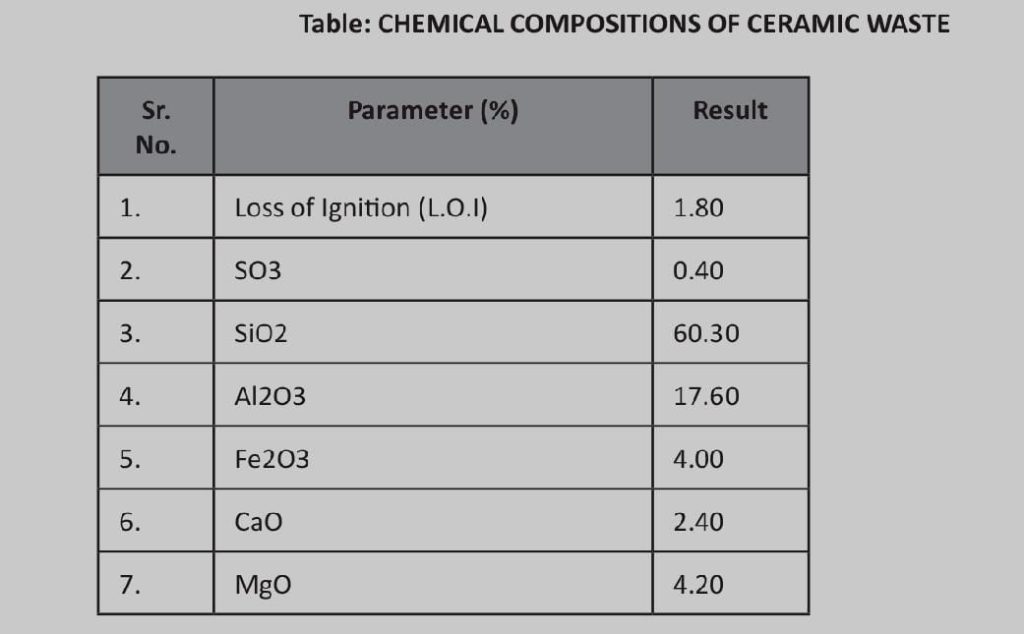Unique Registration Number: 149
Innovator Name:
MR. KAUSHIK S. FAL DESSAI
MR. RAVINDRA GURAV
MR. SAPNESH B. JANGLI
MR. ANVIT A. KELEKAR
MR. SAGAR S. LAWANDE
Contact No: +91
Contact Email:
Project Objective:
The objective of study are as follows:
- To examine the effectiveness of using Ceramic Waste Powder (CWP), as partial replacement of cement by studying strength parameters.
- To study the necessity of consumption of the waste material for manufacturing of sustainable concrete for construction. To use locally available material and to reduce the cost of producing concrete.
- To overcome the problems faced by cement industries to a little extent.
- To investigate the compressive strength and split tensile strength of concrete with CWP to that of normal concrete.
- To prepare high strength, eco-friendly and cost effective concrete.
Abstract:
The advancement of concrete technology can reduce the consumption of natural resources, which can be reused and find other alternatives. In India numbers of waste materials are produced by different manufacturing companies, thermal power plant, municipal solid wastes and other wastes. Solid as well as liquid waste management is one of the biggest problems of the whole world. Disposal of waste in to the land causes serious impact on environment. Nowadays large amount of tile powder is generated in tile industries with an impact on environment and humans. By using the replacement materials offers cost reduction, Energy saving sand few hazards in the environment. Concrete is nothing but a combination of aggregates both fine and coarse, Cement and water. Comparing to all other ingredients in concrete, cement is considered to be the expensive material. This is because cement is manufactured using energy-intensive process. Cement is one of the major producers of carbon dioxide, which is the main cause of global warming. During the manufacturing process of cement the formation of clinker can be achieved only by heating the cement at very high temperature. This leads to the release of enormous amounts of carbon in the atmosphere. This was one among the major problems identified for climatic changes. Various research works has been carried out for the cost reduction in construction with some of the locally available materials as the partial or full replacement material for cement. Over the last few decades supplementary materials like fly ash, rice husk, silica fume, eggshell, groundnut shell, etc. are used as a replacing material.
These supplementary materials have proven to be successful in meeting the needs of the concrete in construction. Ceramic waste is one of the most active research areas that encompass a number of disciplines including civil engineering and construction materials. Ceramic waste powder is settled by sedimentation and then dumped away which results in environmental pollution, in addition to forming dust in summer and threatening both agriculture and public health. Therefore, utilization of the ceramic waste powder in various sectors especially the construction would help to reduce the cost of concrete and also result in decrease of environmental burden due of recycling of ceramic waste. In this research study the cement will be partially replaced by ceramic waste powder accordingly in the range of 10% 20%, 30% by weight of M30 grade. M30 grade concrete will be prepared using 0.43 water cement ratio considering weight batching.
Project Outcome/result/findings:
The following results were obtained after the testing of materials which are required to
prepare the concrete.

Innovative Approach:
Various tests were conducted to check the properties of the coarse aggregate and some of the tests including the specific gravity, fineness modulus, Initial & Final setting time etc. The Nanu crushed sand was used as the fine aggregate in this study. Various tests were conducted for fine aggregate also to find out the fineness of sand, specific gravity of sand etc. The test for cement was carried out to find the specific gravity, fineness etc. Mix Design of M30 grade concrete was carried out as per IS 10262-2019 and trials were conducted. Bharthi OPC 53 grade cement was used. Ceramic powder was used as partial cement replacement for making the concrete specimens. Asian paints admixture was used in concrete mix. Concrete Cubes were put for accelerated curing in an accelerated curing tank, 23 hours after casting. Concrete Cubes were kept immersed in a curing tank with water at 100 degree Celsius for 3 hours and later kept immersed in a cool water tank for 2 hours.

